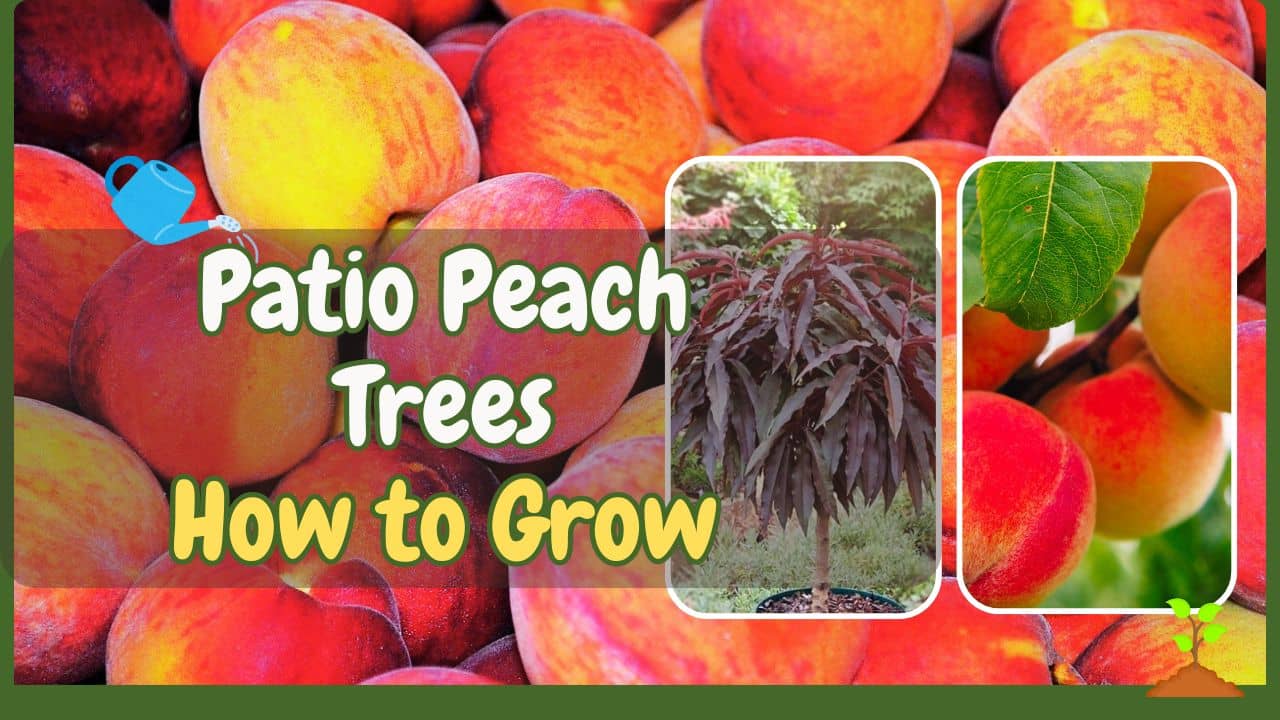If you’ve ever dreamed of having your very own peach tree but thought you didn’t have the space — here’s some good news: you absolutely can.
Patio peach trees are the small-space gardener’s secret weapon. These compact, colorful trees are designed to thrive in containers, offering the beauty of flowering peaches and the satisfaction of growing your own fruit — even on a tiny balcony or patio.
Whether you live in an apartment or have a modest backyard, this guide will walk you through everything you need to know — from choosing the right variety to planting, caring, and enjoying your patio peaches year after year.
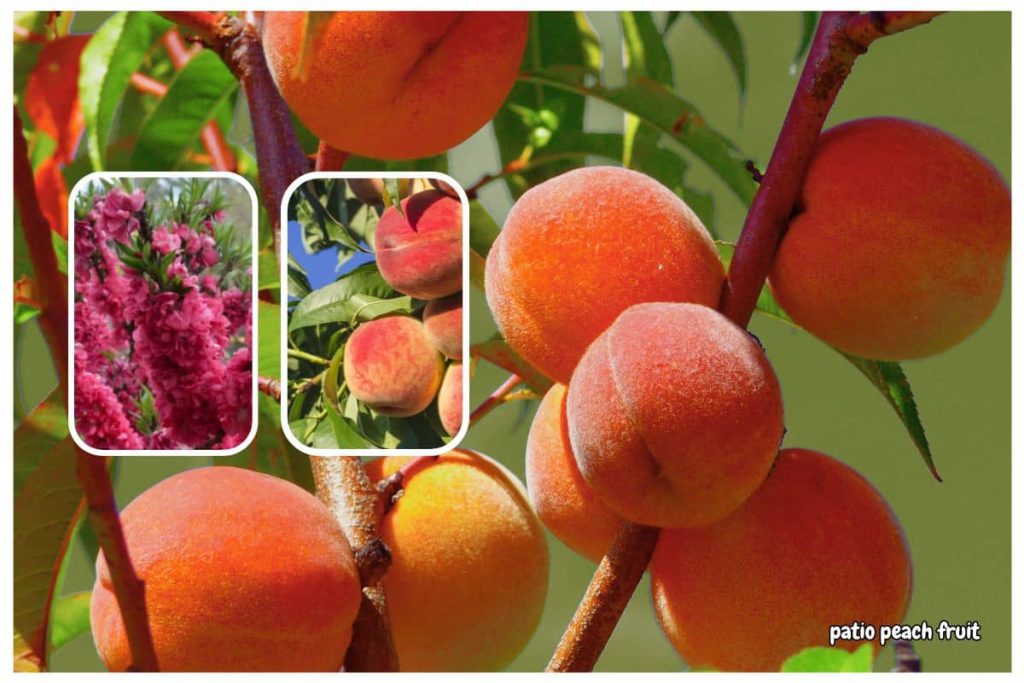
Let’s dig in!
Table of Contents
🌸 What Are Patio Peach Trees?
Patio peach trees are dwarf peach trees specially bred to stay compact while maintaining all the charm and features of their larger cousins. Instead of shooting up to 15 or 20 feet, these little beauties typically reach 4 to 6 feet tall, making them perfect for growing in pots or planters.
Despite their smaller size, patio peaches aren’t just for decoration. Many varieties — including the popular Bonfire Patio Peach Tree — produce real, edible peaches! They might be smaller and fewer in number, but they’re every bit as sweet and fragrant.
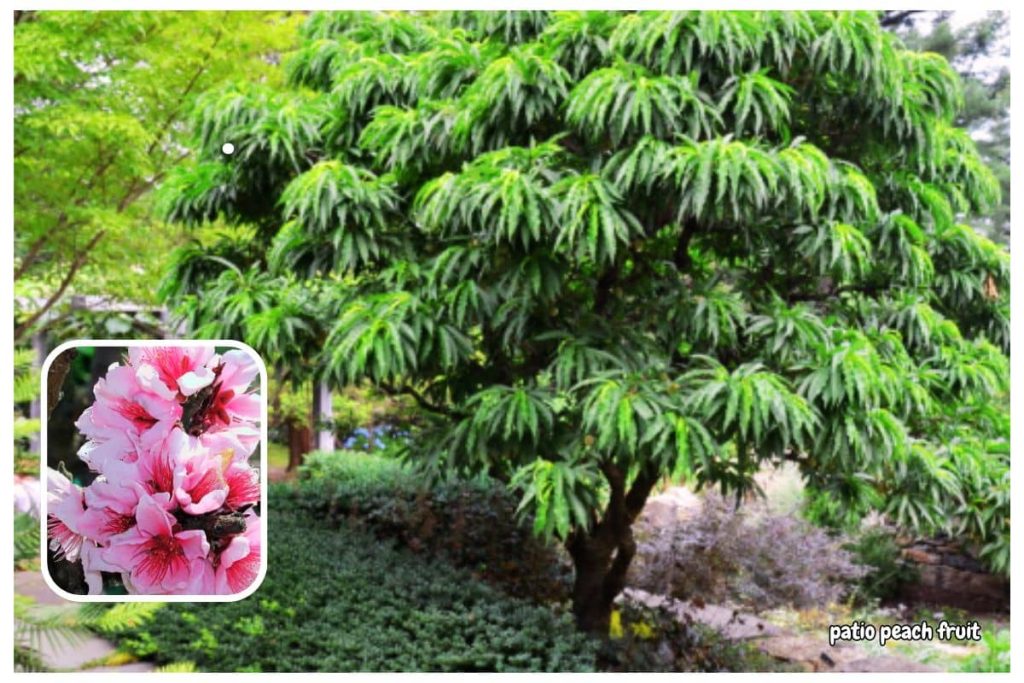
Why Patio Peach Trees Are So Popular
- Perfect for small spaces: Great for patios, balconies, or front porches.
- Beautiful year-round: Pink blossoms in spring, deep red or burgundy leaves in summer, and fiery orange foliage in fall.
- Low maintenance: No need for ladders or heavy pruning.
- Versatile: Grow them indoors during winter or outdoors in summer.
So, if you’ve ever wanted a touch of orchard beauty without the commitment of a large garden, a patio peach tree might just be your perfect match.
🌳 The Bonfire Patio Peach Tree: Compact and Colorful
Among all the varieties, the Bonfire Patio Peach Tree is easily one of the most beloved — and for good reason.
This tree is a true showpiece, producing vibrant pink blossoms each spring that fade into burgundy-purple foliage as the season progresses. In autumn, those same leaves turn a brilliant shade of orange-red, giving you months of changing color and visual interest.
Oh, and yes — it also bears fruit!
The peaches are small but edible, with a mild, sweet flavor. They’re perfect for a gardener who enjoys both beauty and a little homegrown harvest.
Typical Bonfire Patio Peach Tree Size
- Height: 4 to 6 feet
- Spread: 4 to 5 feet
- Container size: 18–24 inches wide, with good drainage
- Hardiness: USDA Zones 5–9
This makes it incredibly easy to move around — whether you’re bringing it into a garage for winter protection or repositioning it on your patio to catch more sunlight.
How to Plant Patio Peach Trees
Growing patio peach trees starts with good planting practices. Fortunately, they’re beginner-friendly, and you can get your tree thriving with just a few simple steps.
Step 1: Choose the Right Container
Go for a pot that’s at least 18–24 inches wide and deep.
Terracotta or resin pots work best because they allow air to flow and regulate temperature.
Make sure there are drainage holes — peach roots can’t stand sitting in water.
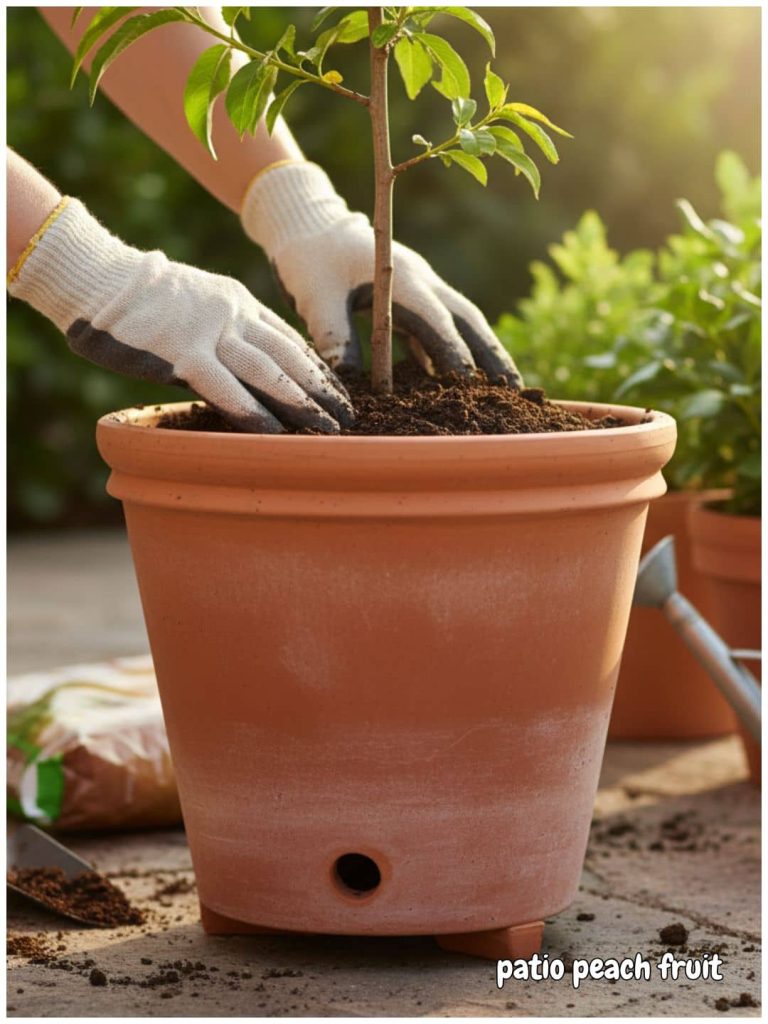
Step 2: Prepare the Perfect Soil Mix
Patio peaches love well-draining, nutrient-rich soil.
Try this mix:
- 60% high-quality potting mix
- 20% compost or aged manure
- 20% perlite or coarse sand for better aeration
Keep the soil slightly acidic, ideally around pH 6.0–6.5.
Step 3: Plant the Tree
- Remove your patio peach tree from its nursery container and gently loosen the roots.
- Place it in the new pot, keeping the crown (where the trunk meets the soil) level with the surface.
- Backfill with your soil mixture and press gently to eliminate air pockets.
- Water thoroughly until it drains from the bottom of the pot.
Step 4: Find the Perfect Location
Your patio peach tree will thrive in full sun, so choose a spot that gets at least 6–8 hours of direct sunlight daily. If you’re growing indoors, use a south-facing window or supplement with a grow light.
🌞 How to Care for Patio Peach Trees
Once planted, patio peach trees don’t demand much — just regular watering, feeding, and a bit of seasonal maintenance. Here’s a breakdown of what they need throughout the year:
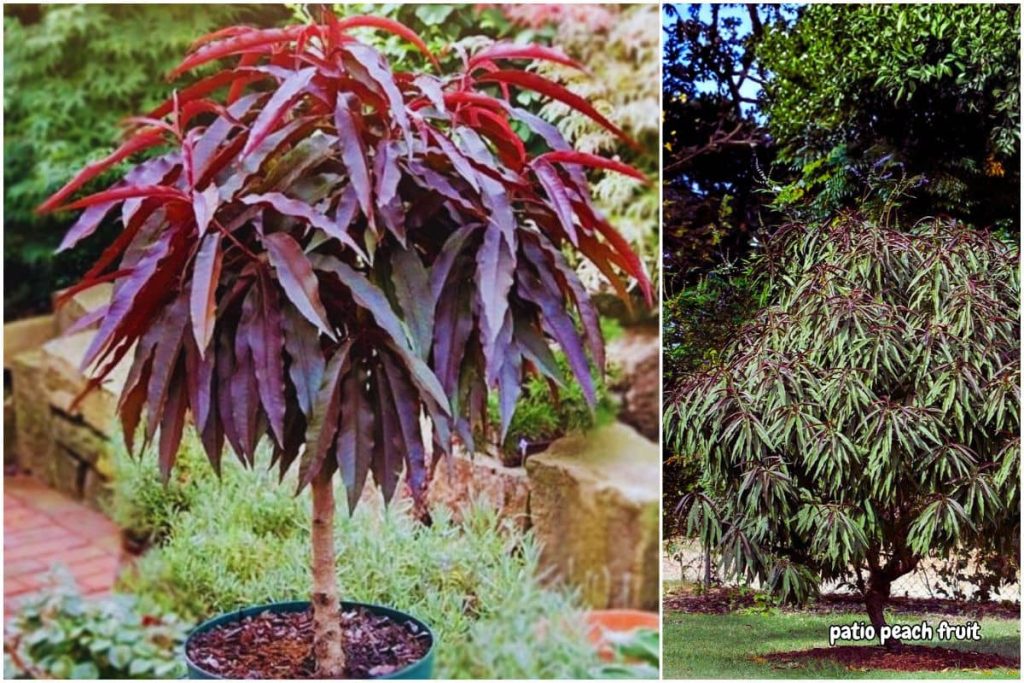
Watering Schedule
- Spring to Summer: Water deeply once or twice a week. Keep the soil evenly moist but not soggy.
- Fall: Gradually reduce watering as temperatures cool.
- Winter: Water only once every 2–3 weeks — just enough to prevent the roots from drying out.
💡 Pro Tip: Stick your finger into the soil about an inch deep. If it feels dry, it’s time to water.
Fertilizing
Patio peaches appreciate a boost of nutrients during their active growing months.
| Season | Fertilizer Type | Purpose |
|---|---|---|
| Early Spring | Balanced fertilizer (10-10-10) | Supports new growth and flowering |
| Mid-Summer | Slow-release organic fertilizer | Maintains strong foliage and fruit development |
| Fall & Winter | None | Tree enters dormancy — let it rest |
Avoid overfeeding. Too much nitrogen can lead to lush leaves but fewer blossoms or fruit.
Sunlight Needs
The more sun, the better! Patio peaches need at least 6 hours of direct sunlight daily. Without enough light, they’ll produce fewer flowers and fruit.
🌿 Seasonal Patio Peach Tree Care
Each season brings its own set of tasks. Following this easy routine will keep your patio peaches healthy and thriving year after year.
🌷 Spring: Bloom and Growth
- Prune away any dead or weak branches before new growth starts.
- Fertilize early to boost flowering and leaf development.
- Keep an eye out for aphids or leaf curl — early treatment prevents big problems later.
- Enjoy the blossoms! This is when your Bonfire Patio Peach Tree truly shines.
🌞 Summer: Fruiting and Foliage
- Water consistently to avoid drought stress.
- Check for pests regularly (spider mites, scale insects).
- If your tree is fruiting, support branches if needed — even small peaches can weigh them down.
- Add mulch around the base to keep roots cool and conserve moisture.
🍂 Fall: Wind-Down and Color Show
- Enjoy the color change! The leaves turn deep red and orange, making your patio a mini autumn display.
- Reduce watering gradually.
- Lightly prune any crossing or spent branches.
- Add compost or organic matter to the soil before winter.
❄️ Winter: Rest and Protection
- If temperatures drop below 30°F, move your potted tree into a sheltered area like a garage or sunroom.
- Water sparingly — only enough to keep the roots from drying out.
- No fertilizer during dormancy.
- Check occasionally for overwintering pests.
🍑 Common Patio Peach Tree Varieties
Choosing the right variety is half the fun! Here are a few top picks to suit different goals and aesthetics.
| Variety | Height | Foliage Color | Edible Fruit | Ideal For |
|---|---|---|---|---|
| Bonfire Patio Peach | 4–6 ft | Burgundy to red | Yes | Best all-around choice for small patios |
| Bonanza Patio Peach | 5–6 ft | Green | Yes, juicy | For gardeners who want more fruit yield |
| Crimson Bonfire Peach | 5–7 ft | Red-green mix | Slightly edible | Great for ornamental use |
| Ruby Ruffle Patio Peach | 4–5 ft | Ruffled burgundy | No | Best for decorative displays |
| Dwarf Elberta Peach | 6–8 ft | Green | Yes, large | For slightly larger spaces with fruit focus |
If your goal is aesthetics and easy care, go for the Bonfire Patio Peach Tree. If you’re after bigger, more edible fruit, Bonanza or Dwarf Elberta are worth considering.
🌺 Pruning and Maintenance Tips
Even though they’re small, patio peach trees benefit from occasional pruning to keep their shape and encourage new growth.
When and How to Prune
- Prune lightly in late winter or early spring before new buds appear.
- Remove any dead, broken, or crossing branches.
- Maintain an open center shape to improve air circulation.
- After flowering, a light trim can help manage the bonfire patio peach tree size and keep it compact.
Repotting
Every 2–3 years, refresh your patio peach’s soil and upgrade its container if needed. This prevents the roots from becoming crowded and restores essential nutrients.
🍃 Troubleshooting Common Issues
| Problem | Likely Cause | Solution |
|---|---|---|
| Yellow leaves | Overwatering | Let soil dry out and improve drainage |
| No flowers | Too little sunlight or too much fertilizer | Move to full sun, reduce feeding |
| Leaf curl | Fungal infection | Apply copper fungicide early in spring |
| Pests (aphids, mites) | Dry or dusty leaves | Spray neem oil weekly |
| Weak growth | Old soil or root binding | Repot with fresh soil, trim roots lightly |
Keeping your tree healthy often comes down to consistency — regular watering, sunlight, and airflow go a long way.
🏡 Decorating Ideas with Patio Peach Trees
Beyond their beauty as fruiting trees, patio peach trees make stunning design features.
- Patios & Decks: Place one on each side of your entryway for a balanced look.
- Balconies: Use tall pots to elevate your trees and add vertical greenery.
- Garden Borders: Mix patio peaches with herbs like rosemary and thyme for contrast.
- Small Yards: Group several in matching containers for a mini orchard vibe.
“Check out more Top 5 Dwarf Fruit Trees for Small Gardens | Small-Space Gardening Guide“.
🌿 Where to Buy Patio Peach Trees
When shopping, always choose a healthy plant from a reputable nursery.
Trusted U.S. sources:
- Brighter Blooms Nursery – Great quality Bonfire Patio Peach Trees with home delivery.
- Nature Hills Nursery – Wide variety of dwarf fruit trees.
- The Old Farmer’s Almanac – Expert advice and planting resources.
Before buying, check your USDA Hardiness Zone on the USDA Zone Map to ensure your tree will thrive.
🌸 Conclusion
Growing patio peach trees is one of the easiest and most rewarding ways to bring life, color, and a touch of sweetness to your outdoor space.
They’re compact, low-maintenance, and absolutely stunning through all four seasons — from spring’s pink blossoms to fall’s fiery leaves.
Whether you choose a Bonfire Patio Peach Tree for its beauty or a Bonanza Peach for its fruit, you’ll find that these dwarf trees are proof that even the smallest spaces can yield something truly special.
So grab a pot, some good soil, and a sunny spot — and let your patio become your own personal peach paradise. 🍑
How long does it take for a peach tree to produce fruit?
A peach tree usually starts producing fruit in 2 to 4 years after planting, depending on the variety and growing conditions.
What are the most expensive peaches?
The Shimizu White Peach from Japan is considered the most expensive, often selling for over $10–$15 per peach due to its perfect sweetness, size, and appearance.
3. Which country is the world’s largest producer of peaches?
China is the world’s largest producer of peaches, contributing over half of the global supply each year.


